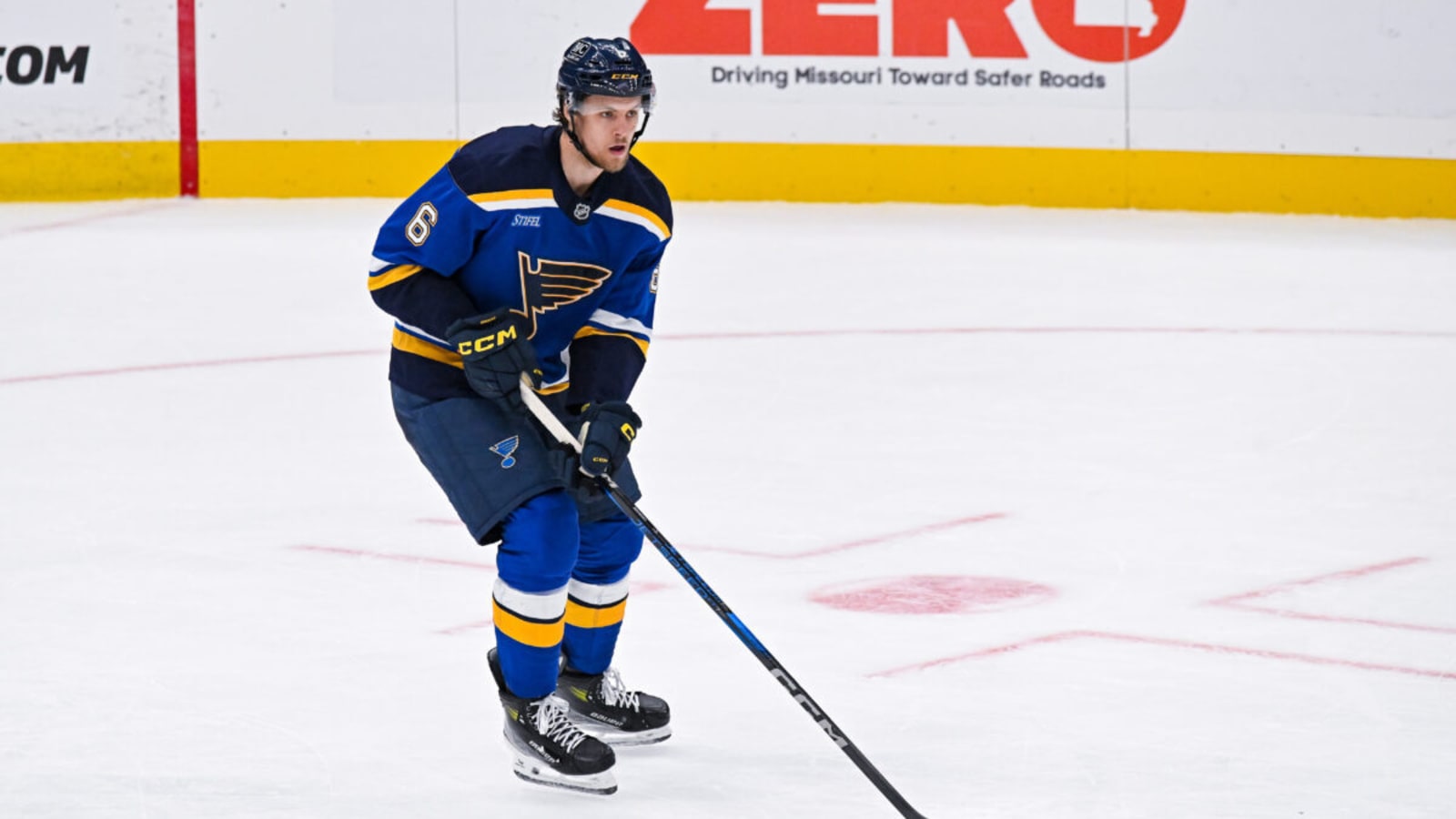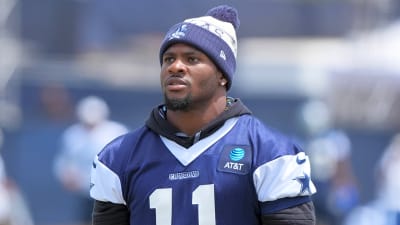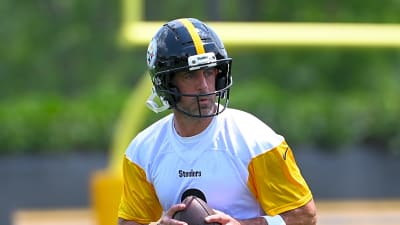
On paper, the St. Louis Blues aren’t much of a threat for the Stanley Cup. Coming off a first-round exit as an eighth seed and an offseason where minimal upgrades were made, they’re seemingly poised for another early playoff departure. But in reality, the Blues may be more of a wagon than they’re getting credit for. What makes them a dark horse contender for 2025–26?
Broberg, Fowler Additions Transformed Blues’ Defense
Entering the 2024 offseason, the Blues’ defense wasn’t anything special. It was more or less a minute-munching Colton Parayko—with substandard results—and everyone else. But two huge left-shot additions in relatively quick succession flipped everything on its head.
First, the Philip Broberg offer sheet. The 24-year-old was an afterthought with the Edmonton Oilers, a Cup-hungry team unwilling to experiment with the No. 8 pick in the 2019 NHL Draft. Relegated to a strict depth role when he got usage with the big club, St. Louis’ submission of an offer sheet for him and Dylan Holloway, in a similar situation, provided a new opportunity. The Oilers declined to match, and the rest is history.
Broberg outscored teams 48–28 last season during 5-on-5 action—he was a crucial piece for the Blues. Though he was more of a fourth defenseman based on ice time (20:30 per game), he projects as a long-term No. 3. Among defensemen with 500 minutes of ice time, he ranked in the 69th percentile for expected goal share (52.15%) and the 98th for actual goal share (63.16%).
On Dec. 14, the Blues took themselves to the next level. Needing a top-pairing partner for Parayko, they took a chance on Cam Fowler. For several seasons, the 33-year-old offensively minded blueliner was mercilessly deployed by the rebuilding Anaheim Ducks—he was seventh in NHL ice time between 2020–21 and 2023–24. Poor on-ice results naturally came with that, plummeting Fowler’s stock. Anaheim traded him and a fourth-round pick to St. Louis, receiving a second-rounder and Jeremie Biakabutuka for their troubles.
The Blues paid practically nothing to get him, yet Fowler transformed the team’s top pairing. In 2023–24, Nick Leddy was stapled to Parayko, but the results were not encouraging: 47.57% actual and 42.76% expected goal shares at 5-on-5. When Fowler came into the fold, however, a bad first pairing became one of the best in the NHL. With 63.27% actual and 54.07% expected goal shares, they dominated opponents.
Blues with Fowler and/or Broberg on the ice (5v5):
— Justin Giampietro (@justingiam) July 31, 2025
62.02% goal share, 52.11% xGoal share
Blues without Fowler or Broberg:
46.95% goal share, 46.42% xGoal share
Blues in 2023-24 (no Fowler, Broberg):
47.48% goal share, 44.05% xGoal share
Fowler’s elite puck-moving ability was the perfect complement to Parayko’s high-end shutdown game and mobility. They’re both nearing their mid-30s, so don’t expect the magic to last forever, but they make up one of the league’s best defensive pairings, period.
In a way, the Blues doubled down on their defense. Losing Zachary Bolduc was rough—he’s a young and legitimately good middle-six forward. But Logan Mailloux is essentially a 1-for-1 replacement of Leddy, just with higher upside and $3.125 million in annual salary-cap savings.
This upcoming season, we can expect more of the same from St. Louis’ defense. It’s perhaps the most overlooked unit in the NHL.
Blues’ Forward Core Has Intriguing Upside
The defense made the forwards’ lives a lot easier, heavily contributing toward scoring chances. Still, there’s a lot of talent up front.
Let’s start with Robert Thomas. Somewhat quietly, he tied for fifth in point-scoring (71) from Dec. 1 until the end of the regular season. He’s a true No. 1 center and one of the best playmakers in the NHL—he’s a borderline superstar. Slated to join him on the top line, based on deployment from the end of last season, are wingers Pavel Buchnevich and Jimmy Snuggerud.
While Buchnevich’s 57 points in 76 games don’t jump off the page, he was a terrific linemate for Thomas—they boasted a 61.76% goal share together. Snuggerud fit perfectly alongside the two across 14 total games, split between the regular season and playoffs. This can be a good first line.
If Snuggerud’s ready for that kind of role full-time, everything becomes easier. Jordan Kyrou can again be the primary driver of the second line, where he got the most out of Holloway. At 5-on-5 together, they outscored teams 37–15, forming one of the best forward duos in the NHL by goal share (71.15%). They’ll be centered by either Brayden Schenn or Pius Suter, although both of them would probably be best suited as third-liners.
With a serviceable to good bottom six and American Hockey League (AHL) prospects like Dalibor Dvorsky and Otto Stenberg close to realizing their NHL aspirations, the Blues have an above-average forward core with room for more. This is a strong roster all around.
Central Division Is Wide Open
What’s also working in the Blues’ favor is the Central Division having no clear contender that rises above the rest. Aside from themselves, five teams in the division have a legitimate shot at making the playoffs: the Colorado Avalanche, Dallas Stars, Minnesota Wild, Utah Mammoth, and Winnipeg Jets.
The Wild and Mammoth are wildcard contenders without too much upside beyond that. The most significant competition here are the Avalanche, Stars, and Jets. But the Blues are already on their level. Less than two seconds away from upsetting the Presidents’ Trophy-winning Jets, who are now downgraded following the departure of Nikolaj Ehlers, St. Louis is dangerous.
In my Central Division breakout candidates piece, I struggled to find a player for Colorado but settled on Jack Drury. For Dallas, I chose Mavrik Bourque. These are two bottom-six forwards who likely won’t get much of a chance in the top half of the lineup—in theory, those two teams aren’t really poised for improvement. But the Blues are. With the league’s sixth-best points percentage after the Fowler trade, no divisional foe has the upper hand. If Snuggerud can take a step, and Mailloux is more than a bottom-pairing puck-mover, perhaps St. Louis is above the rest.
Even if they gave the Jets a hard-fought battle, many see an eighth-seeded Blues team and write them off. But they’re a threat in the Western Conference—they’re the NHL’s dark horse.
Stats courtesy of Evolving-Hockey and Natural Stat Trick
More must-reads:
- NHL players who will send their GM a 'thank you' card next summer
- Oilers GM Stan Bowman offers massive Connor McDavid update
- The '2024-25 NFL TD catch leaders' quiz
Breaking News
Trending News
Customize Your Newsletter
 +
+
Get the latest news and rumors, customized to your favorite sports and teams. Emailed daily. Always free!








